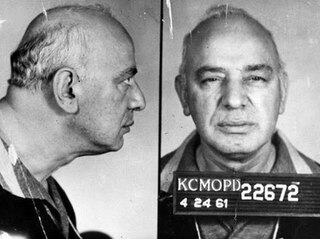
Thomas Joseph Pendergast, also known as T. J. Pendergast, was an American political boss who controlled Kansas City and Jackson County, Missouri, from 1925 to 1939.

Forrest Smith was an American politician who served as the 42nd governor of Missouri. He was a Democrat.

Kansas City is a 1996 American crime film directed by Robert Altman, and starring Jennifer Jason Leigh, Miranda Richardson, Harry Belafonte, Michael Murphy and Steve Buscemi. The musical score of Kansas City is integrated into the film, with modern-day musicians recreating the Kansas City jazz of 1930s.
Gaetano Lococo (1895–1993), also known as "Thomas" or "Tano", was a mobster identified as one of the "Five Iron Men" of Kansas City, Missouri by Americanmafia.com. Lococo was known within the Kansas City crime family as an enforcer in his early years. Later on, he controlled an interest in several illegal gambling establishments.
Silvestro Carollo, nicknamed "Silver Dollar Sam", was an Italian-American mob boss, and boss of the New Orleans crime family. He transformed the New Orleans's Black Hand gang into a Cosa Nostra crime family, and acted as street boss from 1922 to 1944. He was the boss from 1944 until his deportation in 1947. In 1970, he came back to the United States, and died on June 26, 1970.

James Francis Pendergast was a Democratic politician and the first Big City Boss of Kansas City, Missouri. He rose to prominence in the West Bottoms as the proprietor of saloons and gambling establishments and became head of a political faction that held significant control over local politicians and law enforcement in Kansas City. Known as "Alderman Jim," he was known for his generosity to the working-class residents of the industrial areas of the city. He was also repudiated by reform-minded Kansas City elites for spreading the vices of alcohol and gambling, and for his political corruption. He retired from political life in 1910, handing control of his faction to his younger brother Thomas J. Pendergast.

Nicholas Civella was an American mobster who became a prominent boss of the Kansas City crime family.

The Atlantic City Conference held between 13–16 May 1929 was a historic summit of leaders of organized crime in the United States. It is considered by most crime historians to be the earliest organized crime summit held in the US. The conference had a major impact on the future direction of the criminal underworld and it held more importance and significance than the Havana Conference of 1946 and the Apalachin meeting of 1957. It also represented the first concrete move toward a National Crime Syndicate.
The New Orleans crime family, also known as the Marcello crime family or the New Orleans Mafia, was an Italian-American Mafia crime family based in New Orleans, Louisiana. The family had a history of criminal activity dating back to the late nineteenth century. These activities included racketeering, extortion, gambling, prostitution, narcotics distribution, money laundering, loan sharking, fencing of stolen goods, and murder. Operating along the Gulf Coast, with its main criminal activity centered in the New Orleans area, the organization reached its height of influence under bosses Silvestro Carollo and Carlos Marcello.
Charles Vincent "Charlie the Wop" Carrollo was an Italian-born Kansas City, Missouri crime boss during the 1930s.
The Pittsburgh crime family, also known as the LaRocca crime family or the Pittsburgh Mafia, was an Italian-American Mafia crime family based in Pittsburgh, Pennsylvania. The LaRocca family is one of the original twenty-six Mafia families in the United States. The boss and last known "made" member of the family, Thomas "Sonny" Ciancutti, died in 2021.
John Lazia, also known as Brother John, was an American organized crime figure in Kansas City, Missouri, during Prohibition.
The Kansas City crime family, also known as the Civella crime family, the Kansas City Mafia or the Clique, is an Italian-American Mafia crime family based in Kansas City, Missouri.
The Philadelphia crime family, also known as the Bruno–Scarfo crime family, the Philadelphia–Atlantic City crime family, the Philadelphia Mafia, the Philly Mafia, or the Philadelphia–South Jersey Mafia, is an Italian-American Mafia crime family based in Philadelphia, Pennsylvania. Formed and based in South Philadelphia, the criminal organization primarily operates in Philadelphia and the Greater Philadelphia metropolitan area, including South Jersey. The family is notorious for its violence, its succession of violent bosses, and multiple mob wars.
Anthony Robert Gizzo was a Kansas City, Missouri mobster with the Cosa Nostra and a boss of the Kansas City crime family.
Charles Gargotta, also known as "Mad Dog", (1900–1950) was a Kansas City, Missouri, gangster who became a top enforcer for the Kansas City crime family.
William Marshall Boyle Jr. was an American Democratic political activist from Kansas. Chairman of the Democratic National Committee from 1949 to 1951, he was a friend of President Harry S. Truman and is credited with engineering Truman's upset victory over Governor Thomas Dewey in the 1948 Presidential election. He was forced to resign as chairman of the Democratic National Committee after being charged with financial corruption.
Anthony Samuel Carollo was an American mobster, boss of the New Orleans crime family and son of the mob boss Silvestro Carollo. He led the organization from 1990 until his death on February 1, 2007.
This is a list of organized crime in the 1930s, arranged chronologically.
This is a list of organized crime in the 1950s, arranged chronologically.






